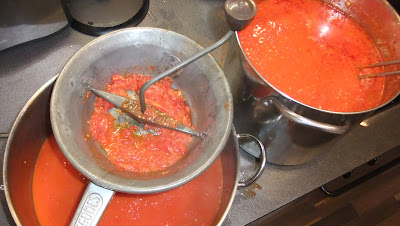of sauce tomatoes. I love getting these in late February or March and cooking
them down to tomato sauce, to be kept for later. To bring a little touch of
sunshine to meals in the depths of winter.


Hands up if you remember “Looking for Alibrandi” – the Melina Marchetta novel that everyone was reading at high schools in the ‘90s. It became a film as well, with Greta Scacchi, Anthony La Paglia, and Pia Miranda. My clearest memory of that book was what they called “National Wog Day” – when the whole family got together to process and preserve the tomato crop. Well, I don’t have much Italian heritage (one great great grandmother), but it’s a tradition I like.

So, here I am on the last weekend in February, with two boxes of Roma tomatoes to convert into tomato passato. That’s 32 kg of tomatoes. Yikes! Better get on with it. At least, I know how to peel a tomato.
 After a while I have a regular production line going.
After a while I have a regular production line going.
Cooked up with just some butter, oil, salt, pepper.

I have an ancient Mouli mill I bought for $1 decades ago from the Salvos at Tempe Tip, and it works a treat to pulp the toms and remove the seeds.


However, by National Wog day standards, it’s not entirely authentic. I’m not doing it in the backyard. I don’t have a line of nonne e zie helping to process the tomatoes. I haven’t improvised a vast Folwer’s Vacola from a 44 gallon drum with a fire underneath. And I’m not bottling them in recycled Resch’s Pilsener longnecks. But it is still fun, with a bunch of tomato passato to freeze as the reward
And, the next day, I found this online:

Clearly, I wasn’t the only one doing National Wog Day! Now,
for a plate of spaghetti al pomodoro ...

